#satellite 2019
Explore tagged Tumblr posts
Text
netflix was so homophobic for not making a season 2 of Julie and the Phantoms and now they’re so homophobic for not releasing Knives Out 2 in a proper cinematic release that lasts more than a fucking week and is available in all theaters
#I'm finding a way to go#but also if I didn't live in a major metropolitan city I wouldn't get to go#and that's bullshit#because the thing is that I will be able to watch it in December because I have broadband internet#and people who don't live in major metropolitan cities (like my parents) (like me before the end of 2019) don't always have that#my mom won't be able to watch it on netflix bc satellite internet has strict data limits and they'll throttle her speeds if she streams
64 notes
·
View notes
Text
I know that this is really big (although expected) but this feels REALLY big if yoy know what i mean?
5 notes
·
View notes
Text
Guillotine
Pretty sure my first 19, and not even sure what the vintage is like. Haven’t researched. I tend not to unless something starts showing quality over and over–like 2018. This feels far less *California* than 2018, big and rich but not quite as lavish and the 18’s, but nowhere near as *french* as 15 and 16. I have good luck with the Saby’s, and picked up this little $40 satellite to give 19 a…

View On WordPress
#Merlotme#2019 Bordeaux#BDX#Bordeaux satellites#Cabernet Franc#Chateau guillou#merlot#Montagne Saint Emilion#Right Bank#Satellite wines#St. Emilion#Stephen McConnell Wine Blog#Steve McConnell Wine Blog#wine1percent
2 notes
·
View notes
Text
Never forget what they took from us

And a laptop

i miss vhs tapes and cds i miss feeding my computers and tvs yummy treats. now theyre eating nothing. theyre being born without mouths
#the lack of disc drives in modern computers makes me want to bite something#a like 2010 toshiba satellite vs a 2019 acer laptop#literally what's in the 2nd picture
147K notes
·
View notes
Text
NASA Inspires Your Crafty Creations for World Embroidery Day
It’s amazing what you can do with a little needle and thread! For #WorldEmbroideryDay, we asked what NASA imagery inspired you. You responded with a variety of embroidered creations, highlighting our different areas of study.
Here’s what we found:
Webb’s Carina Nebula

Wendy Edwards, a project coordinator with Earth Science Data Systems at NASA, created this embroidered piece inspired by Webb’s Carina Nebula image. Captured in infrared light, this image revealed for the first time previously invisible areas of star birth. Credit: Wendy Edwards, NASA. Pattern credit: Clare Bray, Climbing Goat Designs
Wendy Edwards, a project coordinator with Earth Science Data Systems at NASA, first learned cross stitch in middle school where she had to pick rotating electives and cross stitch/embroidery was one of the options. “When I look up to the stars and think about how incredibly, incomprehensibly big it is out there in the universe, I’m reminded that the universe isn’t ‘out there’ at all. We’re in it,” she said. Her latest piece focused on Webb’s image release of the Carina Nebula. The image showcased the telescope’s ability to peer through cosmic dust, shedding new light on how stars form.
Ocean Color Imagery: Exploring the North Caspian Sea
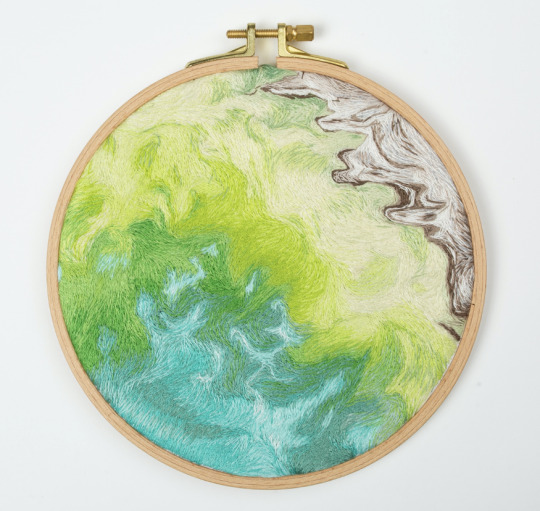
Danielle Currie of Satellite Stitches created a piece inspired by the Caspian Sea, taken by NASA’s ocean color satellites. Credit: Danielle Currie/Satellite Stitches
Danielle Currie is an environmental professional who resides in New Brunswick, Canada. She began embroidering at the beginning of the Covid-19 pandemic as a hobby to take her mind off the stress of the unknown. Danielle’s piece is titled “46.69, 50.43,” named after the coordinates of the area of the northern Caspian Sea captured by LandSat8 in 2019.

An image of the Caspian Sea captured by Landsat 8 in 2019. Credit: NASA
Two Hubble Images of the Pillars of Creation, 1995 and 2015
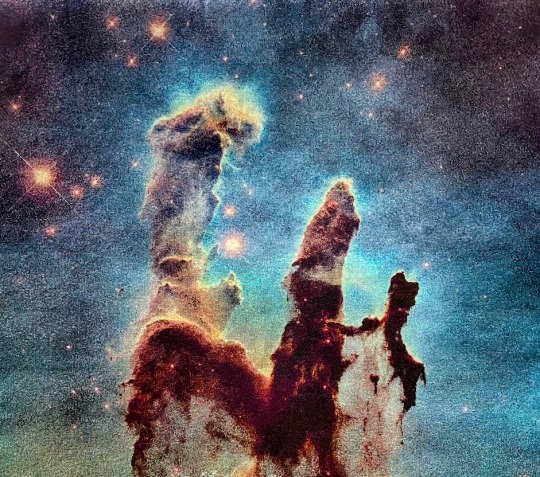
Melissa Cole of Star Stuff Stitching created an embroidery piece based on the Hubble image Pillars of Creation released in 1995. Credit: Melissa Cole, Star Stuff Stitching
Melissa Cole is an award-winning fiber artist from Philadelphia, PA, USA, inspired by the beauty and vastness of the universe. They began creating their own cross stitch patterns at 14, while living with their grandparents in rural Michigan, using colored pencils and graph paper. The Pillars of Creation (Eagle Nebula, M16), released by the Hubble Telescope in 1995 when Melissa was just 11 years old, captured the imagination of a young person in a rural, religious setting, with limited access to science education.
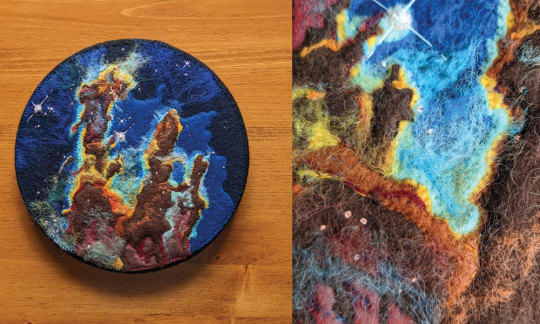
Lauren Wright Vartanian of the shop Neurons and Nebulas created this piece inspired by the Hubble Space Telescope’s 2015 25th anniversary re-capture of the Pillars of Creation. Credit: Lauren Wright Vartanian, Neurons and Nebulas
Lauren Wright Vartanian of Guelph, Ontario Canada considers herself a huge space nerd. She’s a multidisciplinary artist who took up hand sewing after the birth of her daughter. She’s currently working on the illustrations for a science themed alphabet book, made entirely out of textile art. It is being published by Firefly Books and comes out in the fall of 2024. Lauren said she was enamored by the original Pillars image released by Hubble in 1995. When Hubble released a higher resolution capture in 2015, she fell in love even further! This is her tribute to those well-known images.
James Webb Telescope Captures Pillars of Creation

Darci Lenker of Darci Lenker Art, created a rectangular version of Webb’s Pillars of Creation. Credit: Darci Lenker of Darci Lenker Art
Darci Lenker of Norman, Oklahoma started embroidery in college more than 20 years ago, but mainly only used it as an embellishment for her other fiber works. In 2015, she started a daily embroidery project where she planned to do one one-inch circle of embroidery every day for a year. She did a collection of miniature thread painted galaxies and nebulas for Science Museum Oklahoma in 2019. Lenker said she had previously embroidered the Hubble Telescope’s image of Pillars of Creation and was excited to see the new Webb Telescope image of the same thing. Lenker could not wait to stitch the same piece with bolder, more vivid colors.
Milky Way

Darci Lenker of Darci Lenker Art was inspired by NASA’s imaging of the Milky Way Galaxy. Credit: Darci Lenker
In this piece, Lenker became inspired by the Milky Way Galaxy, which is organized into spiral arms of giant stars that illuminate interstellar gas and dust. The Sun is in a finger called the Orion Spur.
The Cosmic Microwave Background
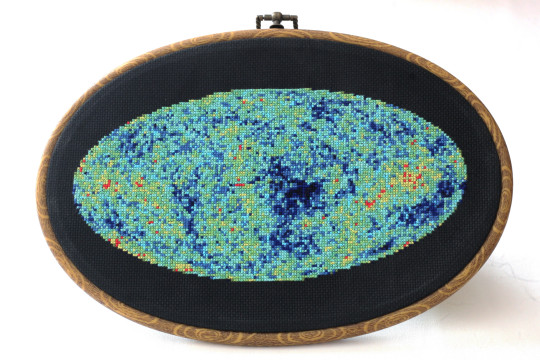
This image shows an embroidery design based on the cosmic microwave background, created by Jessica Campbell, who runs Astrostitches. Inside a tan wooden frame, a colorful oval is stitched onto a black background in shades of blue, green, yellow, and a little bit of red. Credit: Jessica Campbell/ Astrostitches
Jessica Campbell obtained her PhD in astrophysics from the University of Toronto studying interstellar dust and magnetic fields in the Milky Way Galaxy. Jessica promptly taught herself how to cross-stitch in March 2020 and has since enjoyed turning astronomical observations into realistic cross-stitches. Her piece was inspired by the cosmic microwave background, which displays the oldest light in the universe.

The full-sky image of the temperature fluctuations (shown as color differences) in the cosmic microwave background, made from nine years of WMAP observations. These are the seeds of galaxies, from a time when the universe was under 400,000 years old. Credit: NASA/WMAP Science Team
GISSTEMP: NASA’s Yearly Temperature Release

Katy Mersmann, a NASA social media specialist, created this embroidered piece based on NASA’s Goddard Institute for Space Studies (GISS) global annual temperature record. Earth’s average surface temperature in 2020 tied with 2016 as the warmest year on record. Credit: Katy Mersmann, NASA
Katy Mersmann is a social media specialist at NASA’s Goddard Space Flight Center in Greenbelt, Md. She started embroidering when she was in graduate school. Many of her pieces are inspired by her work as a communicator. With climate data in particular, she was inspired by the researchers who are doing the work to understand how the planet is changing. The GISTEMP piece above is based on a data visualization of 2020 global temperature anomalies, still currently tied for the warmest year on record.
In addition to embroidery, NASA continues to inspire art in all forms. Check out other creative takes with Landsat Crafts and the James Webb Space telescope public art gallery.
Make sure to follow us on Tumblr for your regular dose of space!
#NASA#creativity#fiber art#embroidery#art#art challenge#needlework#crafts#handmade#textile art#cross stitch#stitching#inspiration#inspo#Earth#Earth science#Hubble#James Webb Space Telescope#climate change#water#nebula#stars
6K notes
·
View notes
Text
Utah’s getting some of America’s best broadband

TOMORROW (May 17), I'm at the INTERNET ARCHIVE in SAN FRANCISCO to keynote the 10th anniversary of the AUTHORS ALLIANCE.

Residents of 21 cities in Utah have access to some of the fastest, most competitively priced broadband in the country, at speeds up to 10gb/s and prices as low as $75/month. It's uncapped, and the connections are symmetrical: perfect for uploading and downloading. And it's all thanks to the government.
This broadband service is, of course, delivered via fiber optic cable. Of course it is. Fiber is vastly superior to all other forms of broadband delivery, including satellites, but also cable and DSL. Fiber caps out at 100tb/s, while cable caps out at 50gb/s – that is, fiber is 1,000 times faster:
https://www.eff.org/deeplinks/2019/10/why-fiber-vastly-superior-cable-and-5g
Despite the obvious superiority of fiber, America has been very slow to adopt it. Our monopolistic carriers act as though pulling fiber to our homes is an impossible challenge. All those wires that currently go to your house, from power-lines to copper phone-lines, are relics of a mysterious, fallen civilization and its long-lost arts. Apparently we could no more get a new wire to your house than we could build the pyramids using only hand-tools.
In a sense, the people who say we can't pull wires anymore are right: these are relics of a lost civilization. Specifically, electrification and later, universal telephone service was accomplished through massive federal grants under the New Deal – grants that were typically made to either local governments or non-profit co-operatives who got everyone in town connected to these essential modern utilities.
Today – thanks to decades of neoliberalism and its dogmatic insistence that governments can't do anything and shouldn't try, lest they break the fragile equilibrium of the market – we have lost much of the public capacity that our grandparents took for granted. But in the isolated pockets where this capacity lives on, amazing things happen.
Since 2015, residents of Jackson County, KY – one of the poorest counties in America – have enjoyed some of the country's fastest, cheapest, most reliable broadband. The desperately poor Appalachian county is home to a rural telephone co-op, which grew out of its rural electrification co-op, and it used a combination of federal grants and local capacity to bring fiber to every home in the county, traversing dangerous mountain passes with a mule named "Ole Bub" to reach the most remote homes. The result was an immediately economic uplift for the community, and in the longer term, the county had reliable and effective broadband during the covid lockdowns:
https://www.newyorker.com/tech/annals-of-technology/the-one-traffic-light-town-with-some-of-the-fastest-internet-in-the-us
Contrast this with places where the private sector has the only say over who gets broadband, at what speed, and at what price. America is full of broadband deserts – deserts that strand our poorest people. Even in the hearts of our largest densest cities, whole neighborhoods can't get any broadband. You won't be surprised to learn that these are the neighborhoods that were historically redlined, and that the people who live in them are Black and brown, and also live with some of the highest levels of pollution and its attendant sicknesses:
https://pluralistic.net/2021/06/10/flicc/#digital-divide
These places are not set up for success under the best of circumstances, and during the lockdowns, they suffered terribly. You think your kid found it hard to go to Zoom school? Imagine what life was like for kids who attended remote learning while sitting on the baking tarmac in a Taco Bell parking lot, using its free wifi:
https://www.wsws.org/en/articles/2020/09/02/elem-s02.html
ISPs loathe competition. They divide up the country into exclusive territories like the Pope dividing up the "new world" and do not trouble one another by trying to sell to customers outside of "their" turf. When Frontier – one of the worst of America's terrible ISPs – went bankrupt, we got to see their books, and we learned two important facts:
The company booked one million customers who had no alternative as an asset, because they would pay more for slower broadband, and Frontier could save a fortune by skipping maintenance, and charging these customers for broadband even through multi-day outages; and
Frontier knew that it could make a billion dollars in profit over a decade by investing in fiber build-out, but it chose not to, because stock analysts will downrank any carrier that made capital investments that took more than five years to mature. Because Frontier's execs were paid primarily in stock, they chose to strand their customers with aging copper connections and to leave a billion dollars sitting on the table, so that their personal net worth didn't suffer a temporary downturn:
https://www.eff.org/deeplinks/2020/04/frontiers-bankruptcy-reveals-cynical-choice-deny-profitable-fiber-millions
ISPs maintain the weirdest position: that a) only the private sector can deliver broadband effectively, but b) to do so, they'll need massive, unsupervised, no-strings-attached government handouts. For years, America went along with this improbable scheme, which is why Trump's FCC chairman Ajit Pai gave the carriers $45 billion in public funds to string slow, 19th-century-style copper lines across rural America:
https://pluralistic.net/2022/02/27/all-broadband-politics-are-local/
Now, this is obviously untrue, and people keep figuring out that publicly provisioned broadband is the only way for America to get the same standard of broadband connectivity that our cousins in other high-income nations enjoy. In order to thwart the public's will, the cable and telco lobbyists joined ALEC, the far-right, corporatist lobbying shop, and drafted "model legislation" banning cities and counties from providing broadband, even in places the carriers chose not to serve:
https://pluralistic.net/2023/03/19/culture-war-bullshit-stole-your-broadband/
Red states across America adopted these rules, and legislators sold this to their base by saying that this was just "keeping the government out of their internet" (even as every carrier relied on an exclusive, government-granted territorial charter, often with massive government subsidies).
ALEC didn't target red states exclusively because they had pliable, bribable conservative lawmakers. Red states trend rural, and rural places are the most likely sites for public fiber. Partly, that's because low-density areas are harder to make a business case for, but also because these are also the places that got electricity and telephone through New Deal co-ops, which are often still in place.
Just about the only places in America where people like their internet service are the 450+ small towns where the local government provides fiber. These places vote solidly Republican, and it was their beloved conservative lawmakers whom ALEC targeted to enact laws banning their equally beloved fiber – keep voting for Christmas, turkeys, and see where it gets you:
https://communitynets.org/content/community-network-map
But spare a little sympathy for the conservative movement here. The fact that reality has a pronounced leftist bias must be really frustrating for the ideological project of insisting that anything the market can't provide is literally impossible.
Which brings me back to Utah, a red state with a Republican governor and legislature, and a national leader in passing unconstitutional, unhinged, unworkable legislation as part of an elaborate culture war kabuki:
https://www.npr.org/2023/03/24/1165975112/utah-passes-an-age-verification-law-for-anyone-using-social-media
For more than two decades, a coalition of 21 cities in Utah have been building out municipal fiber. The consortium calls itself UTOPIA: "Utah Telecommunication Open Infrastructure Agency":
https://www.utopiafiber.com/faqs/
UTOPIA pursues a hybrid model: they run "open access" fiber and then let anyone offer service over it. This can deliver the best of both worlds: publicly provisioned, blazing-fast fiber to your home, but with service provided by your choice of competing carriers. That means that if Moms for Liberty captures you local government, you're not captive to their ideas about what sites your ISP should block.
As Karl Bode writes for Techdirt, Utahns in UTOPIA regions have their choice of 18 carriers, and competition has driven down prices and increased speeds. Want uncapped 1gb fiber? That's $75/month. Want 10gb fiber? That's $150:
https://www.techdirt.com/2024/05/15/utah-locals-are-getting-cheap-10-gbps-fiber-thanks-to-local-governments/
UTOPIA's path to glory wasn't an easy one. The dismal telco monopolists Qwest and Lumen sued to put them out of business, delaying the rollout by years:
https://www.deseret.com/2005/7/22/19903471/utopia-responds-to-qwest-lawsuit/
UTOPIA has been profitable and self-sustaining for over 15 years and shows no sign of slowing. But 17 states still ban any attempt at this.
Keeping up such an obviously bad policy requires a steady stream of distractions and lies. The "government broadband doesn't work" lie has worn thin, so we've gotten a string of new lies about wireless service, insisting that fiber is obviated by point-to-point microwave relays, or 5g, or satellite service.
There's plenty of places where these services make sense. You're not going to be able to use fiber in a moving car, so yeah, you're going to want 5g (and those 5g towers are going to need to be connected to each other with fiber). Microwave relay service can fill the gap until fiber can be brought in, and it's great for temporary sites (especially in places where it doesn't rain, because rain, clouds, leaves and other obstructions are deadly for microwave relays). Satellite can make sense for an RV or a boat or remote scientific station.
But wireless services are orders of magnitude slower than fiber. With satellite service, you share your bandwidth with an entire region or even a state. If there's only a couple of users in your satellite's footprint, you might get great service, but when your carrier adds a thousand more customers, your connection is sliced into a thousand pieces.
That's also true for everyone sharing your fiber trunk, but the difference is that your fiber trunk supports speeds that are tens of thousands of times faster than the maximum speeds we can put through freespace electromagnetic spectrum. If we need more fiber capacity, we can just fish a new strand of fiber through the conduit. And while you can increase the capacity of wireless by increasing your power and bandwidth, at a certain point you start pump so much EM into the air that birds start falling out of the sky.
Every wireless device in a region shares the same electromagnetic spectrum, and we are only issued one such spectrum per universe. Each strand of fiber, by contrast, has its own little pocket universe, containing a subset of that spectrum.
Despite all its disadvantages, satellite broadband has one distinct advantage, at least from an investor's perspective: it can be monopolized. Just as we only have one electromagnetic spectrum, we also only have one sky, and the satellite density needed to sustain a colorably fast broadband speed pushes the limit of that shared sky:
https://spacenews.com/starlink-vs-the-astronomers/
Private investors love monopoly telecoms providers, because, like pre-bankruptcy Frontier, they are too big to care. Back in 2021, Altice – the fourth-largest cable operator in America – announced that it was slashing its broadband speeds, to be "in line with other ISPs":
https://pluralistic.net/2021/06/27/immortan-altice/#broadband-is-a-human-right
In other words: "We've figured out that our competitors are so much worse than we are that we are deliberately degrading our service because we know you will still pay us the same for less."
This is why corporate shills and pro-monopolists prefer satellite to municipal fiber. Sure, it's orders of magnitude slower than fiber. Sure, it costs subscribers far more. Sure, it's less reliable. But boy oh boy is it profitable.
The thing is, reality has a pronounced leftist bias. No amount of market magic will conjure up new electromagnetic spectra that will allow satellite to attain parity with fiber. Physics hates Starlink.
Yeah, I'm talking about Starlink. Of course I am. Elon Musk basically claims that his business genius can triumph over physics itself.
That's not the only vast, impersonal, implacable force that Musk claims he can best with his incredible reality-distortion field. Musk also claims that he can somehow add so many cars to the road that he will end traffic – in other words, he will best geometry too:
https://pluralistic.net/2022/10/09/herbies-revenge/#100-billion-here-100-billion-there-pretty-soon-youre-talking-real-money
Geometry hates Tesla, and physics hates Starlink. Reality has a leftist bias. The future is fiber, and public transit. These are both vastly preferable, more efficient, safer, more reliable and more plausible than satellite and private vehicles. Their only disadvantage is that they fail to give an easily gulled, thin-skinned compulsive liar more power over billions of people. That's a disadvantage I can live with.

If you'd like an essay-formatted version of this post to read or share, here's a link to it on pluralistic.net, my surveillance-free, ad-free, tracker-free blog:
https://pluralistic.net/2024/05/16/symmetrical-10gb-for-119/#utopia

Image: 4028mdk09 (modified) https://commons.wikimedia.org/wiki/File:Rote_LED_Fiberglasleuchte.JPG
CC BY-SA 3.0 https://creativecommons.org/licenses/by-sa/3.0/deed.en
335 notes
·
View notes
Text
"Around the world, mangrove forests have undergone a decades-long decline that is just now slowing to a halt.
In Pakistan, by contrast, mangroves expanded nearly threefold between 1986 and 2020, according to a 2022 analysis of satellite data.
Experts attribute this success to massive mangrove planting and conservation, as well as concerted community engagement.
Many in Pakistan are looking to mangroves to bolster precious fish stocks and defend against the mounting effects of climate change — even as threats to mangroves, such as wood harvesting and camel grazing, continue with no end in sight."
"His sandaled feet drenched in black mud, Rashid Rasheed points to one of the mangrove nurseries he’s been looking after for the past few years. With wooden walls topped by green netting, a dozen nurseries shelter thousands of saplings.
Rasheed, a researcher and nursery expert with the government of Balochistan province in Pakistan, has been leading a drive to establish nurseries in the coastal town of Dam. The goal is to expand and enhance the town’s scattered patches of natural mangrove forest, which have shriveled due to human activities.
“These nurseries have 50,000 saplings that are ready to be transported to the creeks for planting” Rasheed tells Mongabay.
Rasheed’s work is part of a five-year project initiated in 2019 by the Chinese Academy of Sciences’ South China Sea Institute of Oceanography that has planted mangroves on 16 hectares (40 acres) at Dam, and at other sites in Balochistan and neighboring Sindh province.
It’s one of many projects aiming to restore Pakistan’s mangroves. These semiaquatic trees offer a host of benefits, such as protecting coasts against storms and rising sea levels, providing habitat for fish, birds, and other wildlife, sequestering carbon better than most other ecosystems on Earth, and sustaining the livelihoods of some 120 million people globally, according to the IUCN.
Around the world, mangrove forests have undergone a decades-long decline that’s just now slowing to a halt. But Pakistan bucks this trend. The country’s mangroves expanded from 48,331 hectares in 1986 to 143,930 hectares in 2020 (119,430 to 355,659 acres), a nearly threefold increase, according to a 2022 analysis of satellite data. “It is because of the constant endeavor by government and NGOs,” the analysis states, citing restoration, research, and awareness-raising campaigns “now being religiously carried out to conserve and regrow mangroves” by local, national and foreign bodies. Fishing communities, who depend on mangroves for fuel, shelter and as fish nurseries, are often key to the success of Pakistan’s mangrove restoration, providing the labor for planting and protection."
-via Mongabay, February 5, 2024
#pakistan#mangrove#forest#ecosystem#reforestation#carbon emissions#climate change#climate crisis#climate action#fishing#community engagement#good news#hope
362 notes
·
View notes
Text
I keep thinking about a post or a comment I saw months ago that basically said, "if this isn't a genocide then why haven't I seen any photos of Israel on fire"
So here are some photos of Israel on fire.
Starting with the obvious:
October 7th, 2023. Hamas attacked 21 towns. Be'eri, Kfar Aza, Re'im, and Nir Oz were essentially burned to the ground; it will take years to rebuild them.
Satellite images during the attack show fires burning all over.

On October 7, Israel’s farming industry lost approximately 40% of its workforce and 30% of its physical area when the nation’s agricultural center became a warzone and the site of mass death and destruction.
The war forced thousands of people in Israel’s north and south to abandon their homes, leaving hundreds of acres of farmland to lie fallow while the IDF secured the area from further Hamas attacks.
Devastating losses About 20% of Israel’s agricultural land is located in the Gaza border area.... 75% of the vegetables consumed in Israel usually come from the Gaza border region, plus 20% of the fruit and 6.5% of the milk. Meanwhile, Israel’s northern region — which has been facing increasing rocket attacks from Hezbollah in Lebanon — accounts for a third of the country’s agricultural land, and according to the Agriculture and Rural Development Ministry, about 73% of its domestic egg production is concentrated in the Galilee and Golan regions.
Hezbollah's rocket attacks upon Israeli civilian areas, and Hamas rocket attacks from Lebanon, have caused massive fires across northern Israel.
The elimination of Israel has been a primary goal for Hezbollah, just as it is for Hamas and its affiliated groups.
Unlike Hamas, which targets Jews per se and cites the Protocols of the Elders of Zion to explain why, Hezbollah's reasoning follows that of the dictatorship of Iran:
"God, according to Hezbollah theology, cursed all Jews as blasphemers damned for all time and throughout history. Hezbollah, as well as the political/religious leaders of Iran, believe that the destruction of Israel will bring about the 'reappearance of the Imam (the Shiite Islamic Messiah).'"
Fire and brimstone it is, I guess.
April:
Nature and Parks Authority says that some 80,000 dunams (20,000 acres) in the Upper Galilee and Golan Heights have gone up in flames since the start of the month.

The Katzrin fire in early June:



Since the fighting erupted, the total scorched area in Israel is three times greater than the area consumed by the two greatest fires in Israeli history: the Sha'ar Hagai blaze west of Jerusalem in 1995, and the Mount Carmel forest fire in 2010. In each of those blazes, some 20,000 to 25,000 dunams of forest went up in smoke.
The total area burnt down now is also three times the combined area incinerated in 2016 when extreme weather conditions caused a wave of fires that consumed some 41,000 dunams. A similar size of woodland and forest also burned down during the Second Lebanon War. In 2019, a huge blaze consumed large swaths of central Israel's Mevo Modi'im community.

According to a Haaretz analysis of satellite images, which matches with estimates by authorities, some 210,000 dunams (about 52,000 acres) of land burned down in Israel and Lebanon: about 150,000 dunams in Israel from Hezbollah attacks and Israel Defense Forces anti-aircraft fire, and around 60,000 dunams in Lebanon. The burned-down areas in Israel stretch over a large area in the Galilee and Golan Heights, while in Lebanon they are concentrated near the border – due to the Israeli military policy of setting deliberate fire to [complex fortified] areas there in order to keep Hezbollah combatants away and to damage the vegetation that provides them with cover.
...These included trenches, bunkers, rocket-launching positions and arms storage sites.
June 4:
'If the fire spreads to the mountain – everything changes': Residents try to survive amid Hezbollah rockets

As rockets rain on their homes and wreak havoc, some Israelis believe the government's lackluster response shows it has forfeited the north to terrorists. "This is Hezbollah's new strategy – intentionally firing on open areas to ignite fires and burn the north," says former mayor.
Gay Eyal, the security officer of the Golan Regional Council, hasn't slept a wink since yesterday. More than 20 communities in the north, including two evacuated towns of Avivim and Dovev, fall under his wide purview.
"It seems this is the new method of the enemy: They see and hear what's happening – they understand burning the north is more effective," Eyal stated grimly. "We're coming off a night of fires. And this morning another blaze started in the Yir'on Forest. Our biggest fear is the fire spreading to Mount Meron. If that mountain ignites, all the communities of Meron, Safsufa, and the Galilee panhandle will be in danger." Eyal claims they prepared in advance, positioning 24 water trailer rigs of 1,000 liters each in every community. "It's a drop in the bucket. We geared up this past year with many water trailers to assist with firefighting, but it's not enough. We're working with fire stations in Safed, Kiryat Shmona, Tiberias, and Carmiel – our council is dealing with four fire stations. The firefighters are doing everything they can, working ceaselessly. They're tearing themselves apart, but the fire is spreading like a field of thorns."

...Another resident from the north who was out all night at the various fire scenes also tells Israel Hayom this morning: "It's impossible to describe what we went through here last night. Everything burned, an entire region was ablaze. I drove between the fruit orchards, between communities as the fires raged, and my heart burned. The feeling is terrible, of destruction. There's no way to explain the feeling of people watching their life's work burning before their eyes."

June 12:

Hezbollah launched some 215 rockets and several more missiles and drones at northern Israel on Wednesday, in what it said was a response to the killing of a senior commander in the terror group by an Israeli airstrike a night earlier.
The successive Hezbollah attacks began on Wednesday morning with a barrage of at least 90 rockets fired at several [CIVILIAN] areas in northern Israel, including Tiberias — for the first time amid the war — Safed and Rosh Pina, sending tens of thousands of people to shelters, as Jewish Israelis celebrated the Shavuot holiday.
The Israel Defense Forces said another 70 rockets were then launched at the Mount Meron area, home to a sensitive air traffic control base. Ten more rockets were fired at the northern community of Zar’it, and an anti-tank guided missile struck a factory of the Plasan armored vehicle manufacturer in Kibbutz Sasa, causing damage. Later in the morning, a drone launched from Lebanon detonated in an open area near the northern community of Zivon, local authorities said. Several more rockets were fired in the afternoon hours at the upper and western Galilee areas.
#fire tw#israel hamas war#hezbollah#jumblr#free lebanon too#do people outside of jumblr know that hezbollah basically runs Lebanon and it's Bad Actually?#fuck hamas#wall of words
146 notes
·
View notes
Text
Sonic's going to space!
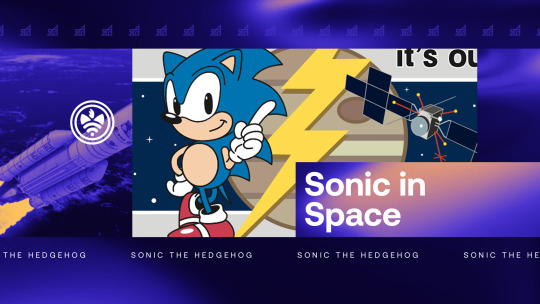
The JUICE (Jupiter Icy Moons Explorer) probe will embark on its eight-year journey to Jupiter and its icy moons, and our favorite blue hedgehog will be on board!
During the development of the probe back in 2019, Swedish scientist Dr. Jan-Erik Wahlund asked SEGA whether they may use Sonic as the mascot of the Radio & Plasma Wave Detector (RPWI) instrument, to which SEGA agreed. According to Dr. Wahlund, they chose Sonic due to their fondness for the character and the fact that he starred in many space adventures.
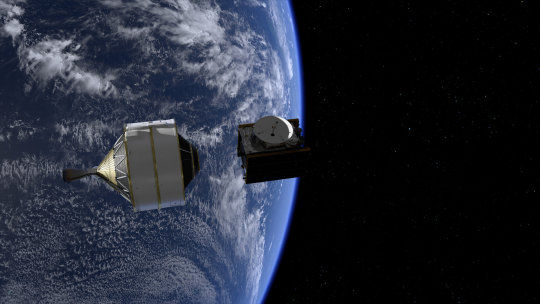
The probe, which will make several fly-bys around a part of our Solar System, will arrive in the Jupiter system in 2031. From there, it will orbit around and study several of Jupiter’s icy moons, particularly Ganymede, and Callisto, and Europa, before settling on orbiting Ganymede’s orbit, becoming the first spacecraft to orbit a natural satellite other than our own Moon.
The spacecraft is scheduled to launch this Friday at 8:14 am ET from Europe's Spaceport in Kourou, French Guiana. The Ariane 5 rocket will bring the probe to space in its final-ever mission.
(Article written by Spectre for the Tails' Channel newsfeed.)
733 notes
·
View notes
Text
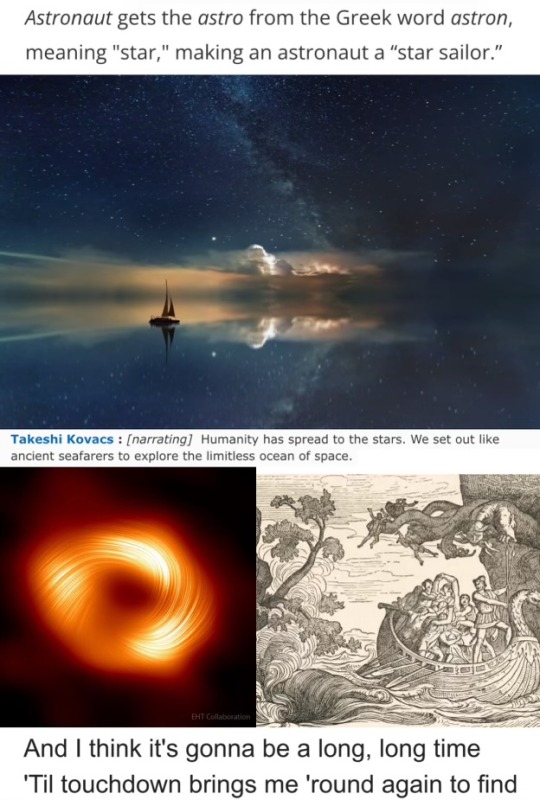


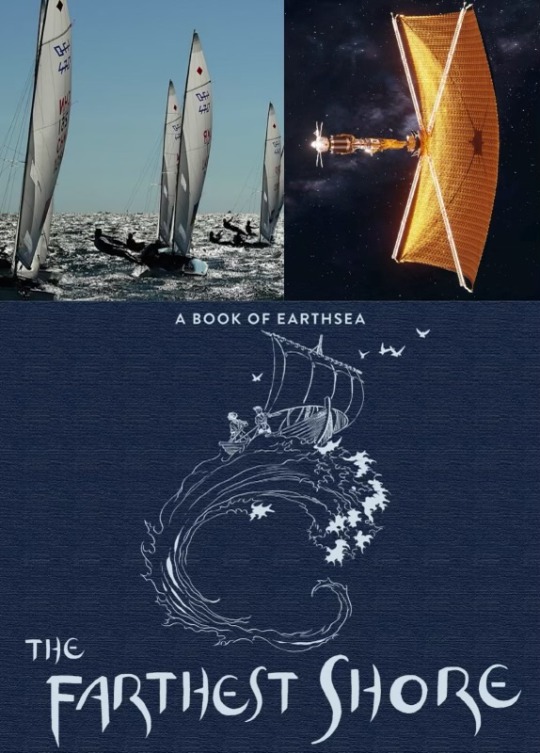




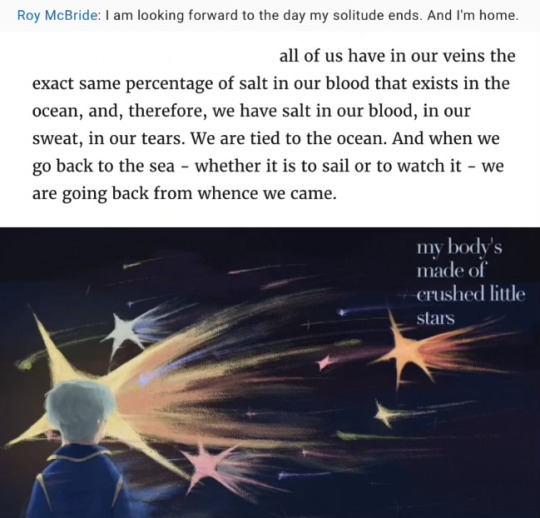
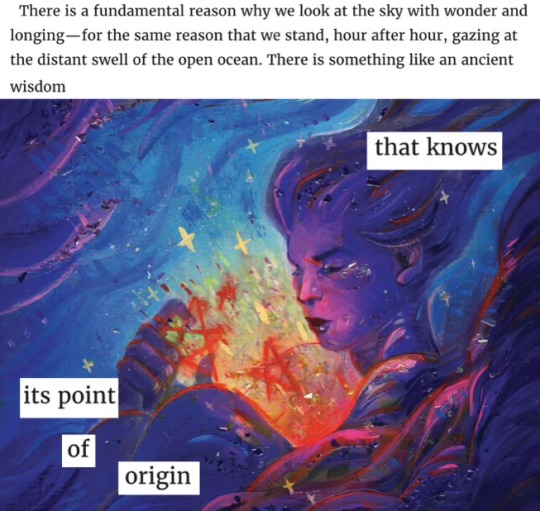
the sea & the stars
as both an escape from and a return to oneself (home lies infinity infinities away from here)
vocabulary.com, definition of astronaut / ? / Altered Carbon, S1 E3: In a Lonely Place / Swirling Magnetic Field around Our Galaxy’s Central Black Hole, EHT Collaboration + Scylla & Charybdis, ? / Rocket Man, Elton John + Ad Astra (2019) / Drops of Jupiter (Tell Me), Train + Life of Pi (2012) / How Far I’ll Go, Auli’i Cravalho/ The Farthest Shore, Ursula K. Le Guin + Odyssey over Martian Sunrise, 3-D (Artist Concept), NASA + The Odyssey, Homer / Pluto, Sleeping at Last / @theedorksinlove + Artist’s Rendition of NASA’s Cassini before it entered Saturn’s atmosphere / Cosmos, Carl Sagan / Olympics.com + Solar Sail, Bert Willemsen / The Farthest Shore, Ursula K. Le Guin / Star Trek (original series) narrative introduction / Where no man has gone before, Wikipedia / Space Oddity, David Bowie + Interstellar (2014) + Seascape Great Ofean Waves Rock Before Storm, ? / The Little Prince, Antoine de Saint-Exupéry / Story People, Brian Andreas + One Piece (anime) / ? / @ghostwriterofthemachine / Chinese Satellite, Phoebe Bridgers / We’re Finally Landing, Home / Ad Astra (2019) / John F. Kennedy / @heypvrker / Astronomical Tidbits: A Layperson’s Guide to Astronomy, Gerald D. Waxman + Made of Star Stuff, Samrae Duke
#PLEASE let me know if you know the source for some of these!#i’m so obsessed by this stuff so yeah#web weaving#sea#ocean#space#stars#ad astra#one piece#<- I think you guys might enjoy this it’s very monkey d luffy coded#Interstellar#star trek#<- yall will prob like this too#UGH. anyways this is like spinning my head always. if you couldn’t tell based on the fact that I go by Rigel#astronomy#nasa#sailing
80 notes
·
View notes
Text


On average, in a new season, between 2013 and 2024, we have gotten:
3-4 rookies,
13-14 riders staying in the same team,
4 riders changing factories,
1 rider being promoted to factory,
the occasional demotion from factory (2 in 12 seasons), satellite teams switch (7) or comeback (5).
Other key numbers :
17 riders started the 2020 season in the same team they started the 2019 season,
Only 9 riders started the 2021 season in the same team they started the 2020 season with,
From 2013 to 2016, for 4 consecutive seasons, 5 of the factory seats were locked in by the same 5 riders : Marc Marquez and Dani Pedrosa with Repsol Honda, Jorge Lorenzo and Valentino Rossi with Yamaha and Andrea Dovizioso with Ducati,
In every single season except for one, the norm is to have at most one rider being promoted to the factory team of the satellite team he worked with the previous season, if any. In this matter, 2021 stands as an anomaly with 4 riders being promoted to factory,
From 2013 to 2024, 5 riders came back to a full-time seat after not having one at least in the previous season.
Full tables with all the riders studied and what they did from 2013 to 2024 under the cut.
Please find more detailed results and rotes, notably on the rookies and the teammates pairings, in the article. You can read the article on any support but it will look nicer on computer.
Don't hesitate to drop a like and/or a comment there or a reblog/ask here. I'm nowhere near an expert at this but I'm always happy to discuss the data I've gathered with people.


#motogp#marc marquez#valentino rossi#fabio quartararo#pecco bagnaia#blogs stuff#stats stuff#this is so stressful for no reason#well I hate when I make mistakes but you also reach a point when you can no longer catch them when you wrote the things in the first place
59 notes
·
View notes
Text
3 HOURS OF GG SINGING - THIS IS NOT A DRILL

Remember a while back I posted about Beijing Satellite TV re-airing a past GG performance? Well actually they aired NEARLY 3 HOURS OF PERFORMANCES, from 2019-2023!!! You can view the performances here. I recommend downloading because it's a priceless collection!!!
To download simply download a browser addon that enables right-clicking on pages that attempt to disable it. Then right-click on the video and select 'save as'. Don't forget to change the quality to 1080p from the default of 720 (you can change that in the bottom right hand corner of the video).
275 notes
·
View notes
Text







ROSWELL, NEW MEXICO (2019-2022)
1.13 ☆ "Recovering the Satellites"
#lizortechoedit#kylevalentiedit#roswellnmedit#roswellnewmexicoedit#rnmedit#cinematv#smallscreensource#userbbelcher#chewieblog#dailytvfilmgifs#filmandtv#latinesource#liz ortecho#kyle valenti#rnm#roswell new mexico#rnm 1x13#bisexualalienss*#coloring this was absolute hell and for what
99 notes
·
View notes
Text
[BEHIND THE RECORD - Elvis onstage from 1969 to 1977] "I Can't Stop Loving You"

Written by country singer Don Gibson, who first recorded it in 1957, RCA Victor released "I Can't Stop Loving You" in 1958, and it became a country hit single. The song was covered by many artists over the years, most notable one being Ray Charles, in 1962, due to how he turned the tune into a No. 1 single on the Billboard chart.
Elvis Presley performed the song in many iconic concerts of his career - from 1969 into the 70s.



The first time Elvis Presley was recorded singing "I CAN'T STOP LOVING YOU" was during one of the American Sound Studio sessions, on February 1969. It wasn't an official recording tho. A jam version of the tune was recorded while EP was warming up with his musicians so they could cut the songs that would be released in his LPs for the times following — "From Elvis In Memphis" being the album this recording session was intending to create at first.
Not long after this recording session, "I Can't Stop Loving You" was worked up as a number to Elvis' concerts. Rearranged, the song gained a more dramatic tone than we can listen to from how it originally sounded in Elvis' voice at the recording taped at the American Sound Studio previously, so from this moment on Elvis would perform the tune in quite a few iconic concerts of the latter era of his career, the very start being during his comeback to live performances on July/August 1969, onstage at the International Hotel's showroom in Las Vegas, Nevada.
Soundboard audios with "I Can't Stop Loving You" recorded during his concerts, including in 1969, were released on some his live albums throughout the years, such as "FROM MEMPHIS TO VEGAS (IN PERSON)" [recorded in 1969], "ELVIS AS RECORDED AT MADISON SQUARE GARDEN" (recorded in 1972) and "ELVIS: RECORDED LIVE ON STAGE IN MEMPHIS" (recorded in 1974).



Live performances of Elvis singing the song were also officially taped, and they are very known to the fans for obvious reasons because they are part of some of the most notable moments of Elvis' history as a performer.
First official taping of EP performing "I Can't Stop Loving You" live took place during one of his engagement seasons at the International Hotel on August, 1970, as released on "Elvis: That's The Way It Is" documentary, then again on April 1972, filmed for "Elvis On Tour" documentary, and not long after that another performance of this tune was filmed during the "Aloha From Hawaii via Satellite" concert, on January 1973.
BUT, BEFORE WE CAN GO TO THOSE FOOTAGES, HAVE YOU LISTENED TO THE JAM VERSION RECORDED IN STUDIO IN 1969?
— NOTE FROM AUTHOR I love sharing Elvis' performances of the same song over the years, but what I would really love you to listen to now is the 1969 jam version of the song we're talking about, for it sounds so different from the live performances the fans are already very familiar with. I didn't knew about this recording until a few days ago and I loved it so much that this track is the reason why I needed to talk about this song. You will read about the moment EP was recording this song soon after.

Elvis Presley in the waiting room of the American Sound Studio, early 1969.
▼ FEBRUARY, 1969: "I CAN'T STOP LOVING YOU", RECORDED AT THE AMERICAN SOUND STUDIO, MEMPHIS, TENNESSEE.
Song starts at 0:35
youtube
Album: American Sound 1969 (2019)
It was an American Studio tradition: paying tribute to the chief with a rendition of “This Time,” a Chips Moman-penned hit for Troy Shondell in 1961. Elvis had heard about the rite, and he serenaded his producer at the start of the February session with the few lines that he knew, segueing into Don Gibson’s “It’s My Way,” a song he had asked Freddy to check out the year before. Plunking along on his acoustic guitar, laughing at his own mistakes but singing his heart out, he drew the band into another Don Gibson number, “I Can’t Stop Loving You,” which he would transform into a dramatic show-stopper six month later in Las Vegas. Excerpt from "Elvis Presley: A Life In Music" by Ernst Jorgensen and Peter Guralnick.
- - - - - - - - - - - - - - - - - - - - - - - - - - - - - - - - - - - - - - - - - - - - - - - -
— NOTE FROM AUTHOR COOL, ISN'T IT? 😍 Have you heard the 1969 jam session version before? Don't know about you but I just can't stop loving it. So, now let's hear how that baby sound onstage.
- - - - - - - - - - - - - - - - - - - - - - - - - - - - - - - - - - - - - - - - - - - - - - - -
[FOOTAGE]
LIVE PERFORMANCES OVER THE YEARS
- - - - - - - - - - - - - - - - - - - - - - - - - - - - - - - - - - - - - - - - - - - - - - - -
REHEARSAL ▼
July, 1970.
youtube
LIVE ONSTAGE ▼
"Elvis: That's The Way It Is" (August 1970) "Elvis On Tour" (April 1972)
youtube
"Aloha From Hawaii via Satellite" (January 14, 1973)
youtube
RECORDED LIVE ▼
Live at Convention Center Arena, San Antonio, TX (April 18, 1972)
youtube
Live at Madison Square Garden (June 10, 1972)
youtube
High Sierra Theatre at the Sahara Tahoe Hotel, Nevada (May 13, 1973)
Live at Mid-South Coliseum, Memphis, TN - March 1974
Song starts at 0:38:
youtube
I can never get enough of how Elvis' history is so amazing. ♥
What are your thoughts about the jam version of "I Can't Stop Loving You" by EP? I'd love to hear from you.
By the way, do you like this track-to-track-history posts? I've written some so far but I have some others I'd like to share too. If you have any requests, any Elvis Presley songs you'd like to know more about the recording sessions or comparisons of the times a same tune was performed live by Elvis over the years, feel free to hit me with it. I sure will have great fun researching it for you.
#elvis presley#elvis#elvis the king#elvis fans#elvis history#elvis fandom#60s elvis#70s elvis#elvis music
64 notes
·
View notes
Text
There’s little doubt that the American government has decided to slow China’s economic rise, most notably in the fields of technological development. To be sure, the Biden administration denies that these are its goals. Janet Yellen said on April 20, “China’s economic growth need not be incompatible with U.S. economic leadership. The United States remains the most dynamic and prosperous economy in the world. We have no reason to fear healthy economic competition with any country.” And Jake Sullivan said on April 27, “Our export controls will remain narrowly focused on technology that could tilt the military balance. We are simply ensuring that U.S. and allied technology is not used against us.”
Yet, in its deeds, the Biden administration has shown that its vision extends beyond those modest goals. It has not reversed the trade tariffs Donald Trump imposed in 2018 on China, even though presidential candidate Joe Biden criticized them in July 2019, saying: “President Trump may think he’s being tough on China. All that he’s delivered as a consequence of that is American farmers, manufacturers and consumers losing and paying more.” Instead, the Biden administration has tried to increase the pressure on China by banning the export of chips, semiconductor equipment, and selected software.
It has also persuaded its allies, like the Netherlands and Japan, to follow suit. More recently, on Aug. 9, the Biden administration issued an executive order prohibiting American investments in China involving “sensitive technologies and products in the semiconductors and microelectronics, quantum information technologies, and artificial intelligence sectors” which “pose a particularly acute national security threat because of their potential to significantly advance the military, intelligence, surveillance, or cyber-enabled capabilities” of China.
All these actions confirm that the American government is trying to stop China’s growth. Yet, the big question is whether America can succeed in this campaign—and the answer is probably not. Fortunately, it is not too late for the United States to reorient its China policy toward an approach that would better serve Americans—and the rest of the world.[...]
Since the creation of the People’s Republic of China in 1949, several efforts have been made to limit China’s access to or stop its development in various critical technologies, including nuclear weapons, space, satellite communication, GPS, semiconductors, supercomputers, and artificial intelligence. The United States has also tried to curb China’s market dominance in 5G, commercial drones, and electric vehicles (EVs). Throughout history, unilateral or extraterritorial enforcement efforts to curtail China’s technological rise have failed and, in the current context, are creating irreparable damage to long-standing U.S. geopolitical partnerships. In 1993 the Clinton administration tried to restrict China’s access to satellite technology. Today, China has some 540 satellites in space and is launching a competitor to Starlink.
When America restricted China’s access to its geospatial data system in 1999, China simply built its own parallel BeiDou Global Navigation Satellite System (GNSS) system in one of the first waves of major technological decoupling. In some measures, BeiDou is today better than GPS. It is the largest GNSS in the world, with 45 satellites to GPS’s 31, and is thus able to provide more signals in most global capitals. It is supported by 120 ground stations, resulting in greater accuracy, and has more advanced signal features, such as two-way messaging[...]
American measures to deprive China access to the most advanced chips could even damage America’s large chip-making companies more than it hurts China. China is the largest consumer of semiconductors in the world. Over the past ten years, China has been importing massive amounts of chips from American companies. According to the US Chamber of Commerce, China-based firms imported $70.5 billion worth of semiconductors from American firms in 2019, representing approximately 37 percent of these companies’ global sales. Some American companies, like Qorvo, Texas Instruments, and Broadcom, derive about half of their revenues from China. 60 percent of Qualcomm’s revenues, a quarter of Intel’s revenues, and a fifth of Nvidia’s sales are from the Chinese market. It’s no wonder that the CEOs of these three companies recently went to Washington to warn that U.S. industry leadership could be harmed by the export controls. American firms will also be hurt by retaliatory actions from China, such as China’s May ban on chips from US-based Micron Technology. China accounts for over 25 percent of Micron’s sales.[...]
The U.S. Semiconductor Industry Association released a statement on July 17, saying that Washington’s repeated steps “to impose overly broad, ambiguous, and at times unilateral restrictions risk diminishing the U.S. semiconductor industry’s competitiveness, disrupting supply chains, causing significant market uncertainty, and prompting continued escalatory retaliation by China,” and called on the Biden administration not to implement further restrictions without more extensive engagement with semiconductor industry representatives and experts.
The Chips Act cannot subsidize the American semiconductor industry indefinitely, and there is no other global demand base to replace China. Other chip producing nations will inevitably break ranks and sell to China (as they have historically) and the American actions will be for naught. And, in banning the export of chips and other core inputs to China, America handed China its war plan years ahead of the battle. China is being goaded into building self-sufficiency far earlier than they would have otherwise. Prior to the ZTE and Huawei components bans, China was content to continue purchasing American chips and focusing on the front-end hardware. Peter Wennink, the CEO of ASML, stated that China is already leading in key applications and demand for semiconductors. Wennink wrote, “The roll-out of the telecommunication infrastructure, battery technology, that’s the sweet spot of mid-critical and mature semiconductors, and that’s where China without any exception is leading.”[...]
Former State Department official Susan Thornton, who oversaw the study as director of the Forum on Asia-Pacific Security at NCAFP, said: “This audit of U.S.-China diplomacy shows that we can make progress through negotiations and that China follows through on its commitments. The notion that engagement with China did not benefit the U.S. is just not accurate.”[...]
One fundamental problem is that domestic politics in America are forcing American policymakers to take strident stands against China instead of pragmatic positions. For instance, sanctions preventing the Chinese Defense Minister, Li Shangfu, from traveling to the United States are standing in the way of U.S.-China defense dialogues to prevent military accidents.
19 Sep 23
128 notes
·
View notes
Text
5 Years, 8 Discoveries: NASA Exoplanet Explorer Sees Dancing Stars & a Star-Shredding Black Hole

This all-sky mosaic was constructed from 912 Transiting Exoplanet Survey Satellite (TESS) images. Prominent features include the Milky Way, a glowing arc that represents the bright central plane of our galaxy, and the Large and Small Magellanic Clouds – satellite galaxies of our own located, respectively, 160,000 and 200,000 light-years away. In the northern sky, look for the small, oblong shape of the Andromeda galaxy (M 31), the closest big spiral galaxy, located 2.5 million light-years away. The black regions are areas of sky that TESS didn’t image. Credit: NASA/MIT/TESS and Ethan Kruse (University of Maryland College Park)
On April 18, 2018, we launched the Transiting Exoplanet Survey Satellite, better known as TESS. It was designed to search for planets beyond our solar system – exoplanets – and to discover worlds for our James Webb Space Telescope, which launched three years later, to further explore. TESS images sections of sky, one hemisphere at a time. When we put all the images together, we get a great look at Earth’s sky!
In its five years in space, TESS has discovered 326 planets and more than 4,300 planet candidates. Along the way, the spacecraft has observed a plethora of other objects in space, including watching as a black hole devoured a star and seeing six stars dancing in space. Here are some notable results from TESS so far:
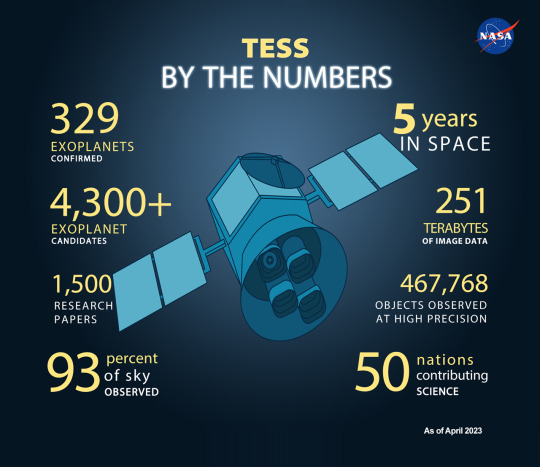
During its first five years in space, our Transiting Exoplanet Survey Satellite has discovered exoplanets and identified worlds that can be further explored by the James Webb Space Telescope. Credit: NASA/JPL-Caltech
1. TESS’ first discovery was a world called Pi Mensae c. It orbits the star Pi Mensae, about 60 light-years away from Earth and visible to the unaided eye in the Southern Hemisphere. This discovery kicked off NASA's new era of planet hunting.
2. Studying planets often helps us learn about stars too! Data from TESS & Spitzer helped scientists detect a planet around the young, flaring star AU Mic, providing a unique way to study how planets form, evolve, and interact with active stars.


Located less than 32 light-years from Earth, AU Microscopii is among the youngest planetary systems ever observed by astronomers, and its star throws vicious temper tantrums. This devilish young system holds planet AU Mic b captive inside a looming disk of ghostly dust and ceaselessly torments it with deadly blasts of X-rays and other radiation, thwarting any chance of life… as we know it! Beware! There is no escaping the stellar fury of this system. The monstrous flares of AU Mic will have you begging for eternal darkness. Credit: NASA/JPL-Caltech
3. In addition to finding exoplanets on its own, TESS serves as a pathfinder for the James Webb Space Telescope. TESS discovered the rocky world LHS 3844 b, but Webb will tell us more about its composition. Our telescopes, much like our scientists, work together.
4. Though TESS may be a planet-hunter, it also helps us study black holes! In 2019, TESS saw a ‘‘tidal disruption event,’’ otherwise known as a black hole shredding a star.
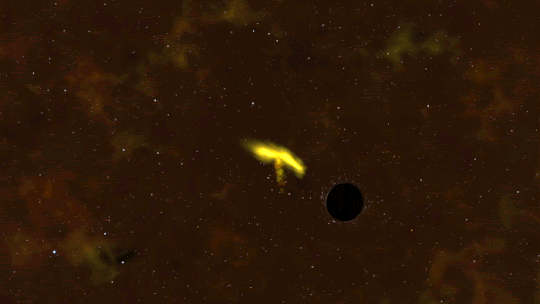
When a star strays too close to a black hole, intense tides break it apart into a stream of gas. The tail of the stream escapes the system, while the rest of it swings back around, surrounding the black hole with a disk of debris. Credit: NASA's Goddard Space Flight Center
5. In 2020, TESS discovered its first Earth-size world in the habitable zone of its star – the distance from a star at which liquid water could exist on a planet’s surface. Earlier this year, a second rocky planet was discovered in the system.
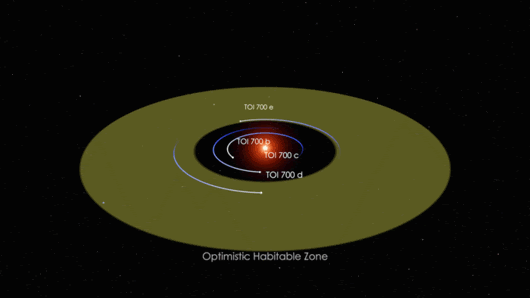
You can see the exoplanets that orbit the star TOI 700 moving within two marked habitable zones, a conservative habitable zone, and an optimistic habitable zone. Planet d orbits within the conservative habitable zone, while planet e moves within an optimistic habitable zone, the range of distances from a star where liquid surface water could be present at some point in a planet’s history. Credit: NASA Goddard Space Flight Center
6. Astronomers used TESS to find a six-star system where all stars undergo eclipses. Three binary pairs orbit each other, and, in turn, the pairs are engaged in an elaborate gravitational dance in a cosmic ballroom 1,900 light-years away in the constellation Eridanus.
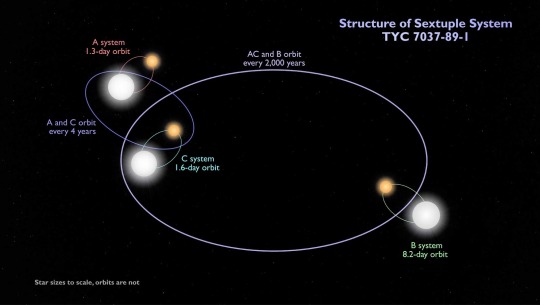
7. Thanks to TESS, we learned that Delta Scuti stars pulse to the beat of their own drummer. Most seem to oscillate randomly, but we now know HD 31901 taps out a beat that merges 55 pulsation patterns.

Sound waves bouncing around inside a star cause it to expand and contract, which results in detectable brightness changes. This animation depicts one type of Delta Scuti pulsation — called a radial mode — that is driven by waves (blue arrows) traveling between the star's core and surface. In reality, a star may pulsate in many different modes, creating complicated patterns that enable scientists to learn about its interior. Credit: NASA’s Goddard Space Flight Center
8. Last is a galaxy that flares like clockwork! With TESS and Swift, astronomers identified the most predictably and frequently flaring active galaxy yet. ASASSN-14ko, which is 570 million light-years away, brightens every 114 days!
Make sure to follow us on Tumblr for your regular dose of space!
#space#planets#exoplanets#science#tech#technology#astronomy#astrophysics#stars#black holes#NASA#spaceblr
2K notes
·
View notes